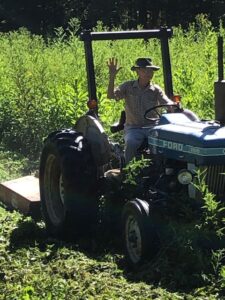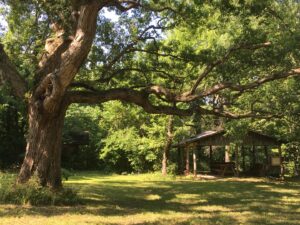Work Continues at Nature Areas during COVID-19
by Bill Mees, Nature Areas Coordinator
How many times have you heard that we are living in unprecedented times, wear masks, social distance, and quarantine? I’m not even going to imagine having a swab stuffed up your nose. All this could really put a stop to almost any planned activities, but not so with Columbia Audubon Society.
The spring warm-up experienced one rain after another. Grass was growing and the outdoors started to show its greenness, especially the honeysuckle. Time to start pulling, which was made easier by the wet ground. Social distancing was no problem as we stalked through the woods, heads down, eyes scanning the ground. Pulling, pulling, and more pulling. Great progress was made removing this ubiquitous invasive at Columbia Audubon Nature Sanctuary (CANS)
Did I say grass was growing? Yes, I did and thanks to Dean Ravenscraft, the trails at CANS, measuring over a mile in distance, are being manicured to a “fare thee well.” Dean’s efforts are especially appreciated by all the new visitors who are prompted to venture out into nature where social distancing is mentally refreshing. According to Parks and Recreation data Scott’s Branch Trail has experienced a 182% increase in usage. Even bicyclists have stopped to hike the trails at CANS. To welcome these guests CAS installed a bicycle hitching post.
You’ve got mail! Longtime CAS member Marj Meredith asks whether there are any Sassafras trees at CANS. No, there aren’t. Marj has the solution, and offers two Sassafras seedlings. This is the second time Marj has helped to return missing Missouri native tree species to the sanctuary. Last time it was Ohio Buckeye seedlings. Thank you Marj Meredith for thinking of Coulumbia Audubon Nature Sanctuary.
Work to build a prairie on the west side of CANS continues. Craig Allee who helped with the first prairie at CANS is back to help prepare another 6 acres. A wooded hillside and scattered areas often wet from rain water runoff, offer an opportunity for a different mix of seeds that will be sown in the winter of 2021.
Another property managed by CAS is the 103 acre Wild Haven Nature Area. Ecologically, Wild Haven is a gem but even gems need an occasional buff up. The shelter has been refurbished and stabilized thanks to the efforts of Jean Neely, Board member, and her husband David, with assistance provided by John Besser and myself. Replacing two posts, installing four 2x8s using 24 bolts and the shelter is almost “good as new.”
The same shelter work crew turned their attention to a mile long Wild Haven trail, clearing fallen trees and overgrown vegetation. This trail that meanders adjacent to Hinkson Creek offers an enjoyable and birdy walk. Adding more strategically located trail markers was a finishing touch to point visitors in the right direction.
Roxie Campbell, a long time member and friend of CAS, is currently planning a field trip to Wild Haven. This educational hike will focus on the trees, vegetation and invasives: how to encourage some and discourage others. Be on the lookout for the announcement for this event.
It’s amazing what CAS has accomplished in spite of COVID-19.


